Digital technologies in steep terrain harvesting
Forest engineers Dr Christian Kanzian and Dr Franz Holzleitner from the University of Natural Resources and Life Sciences in Vienna, BOKU, write about mechanised, digital technologies that have been used in timber extraction in Austria over the last 40 years. They examine the benefits of cable yarding in steep terrain and document how TECH4EFFECT partner, Konrad Forsttechnik, made innovative changes to their latest control system due to SILVISMART exposure.

Cable yarding is currently the most efficient technology used in steep terrain conditions.
Cable yarding moves 3.6m cubic metres of timber per year in Austria
Cable yarding is without exception the only technology that enables sufficient and eco-friendly access for the sustainable use of timber resources and the efficient management of forests in mountainous areas.
In fact, it is only through the development and use of cable yarding in Austria that sustainable management practices of forests are guaranteed in steep terrain. In this type of terrain, the tree is felled manually, but the logs or stems are transported roadside by means of highly-automated, mechanised cable yarders. In 2019, a total of 3.6 million cubic metres (19 per cent of the annual cut) in Austria was supplied with cable yarding technology (Prem 2020).
Cable yarding technology ensures the continuous supply of high-quality raw materials in sufficient quantities to the domestic industry. Simultaneously, modern harvesting technology helps to preserve the multiple functions of the forest for society.
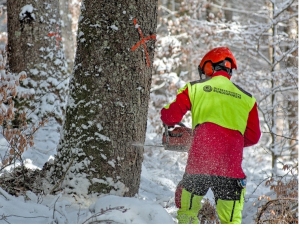
Unexpected for a highly mechanised country like Austria, manual tree felling still plays a major role in timber supply. Picture: C. Kanzian.
Innovative engineering mainstay of continuous improvement
The topic of digitalisation in forestry actually covers a versatile range of technologies and tools. Since the 1980s, mechanised harvesting in the forest technology sector has continuously evolved where innovative engineering has been the mainstay of continuous improvement.
Already in 1982, an Austrian manufacturer, MM Forsttechnik GmbH, equipped and launched the first cable yarder with electronic distance and speed control for carriages and cable remote control for the machine itself. This automised cable yarder has been available to entrepreneurs for almost 40 years and is now an indispensable innovative feature of daily work in the field.
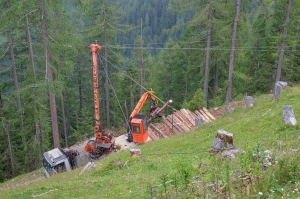
Cables carry logs or stems roadside in steep terrain conditions with less harm to forest soils. Source: C. Kanzian.
Konrad Forsttechnik
Even Konrad Forsttechnik would not have remained competitive without digitalisation since its foundation in 1990. Today, digitalisation not only encompasses the technical possibilities for operating and technically co-ordinating the corresponding harvesting technology itself, but also covers the control and overview for the efficient use of resources, including the monitoring of production progress.
This also includes support for data exchange and communication within the affected participants of the supply chain in mountainous regions. Seamless digital communication requires robust language protocols. StanForD is the robust standard for communication used in forest harvesting machines — established in the late 1980s by the Forestry Research Institute of Sweden (Skogforsk).
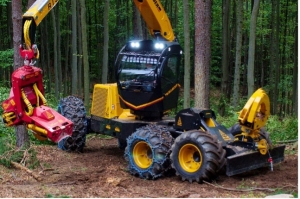
Controlling and production monitoring devices, like onboard computers or tablets, can be found on every modern harvesting machine like the Highlander from Konrad. Source C. Kanzian.
SILVISMART sparks innovation in Konrad control system
Motivated by TECH4EFFECT (T4E) and the development of SILVISMART on the project, Konrad Forsttechnik’s latest control system introduced support for StanForD communication protocols like production reports and control measurements. The inclusion of key functions for daily work in the field, such as production data acquisition and the evaluation of operational data, could be used for reporting to SILVISMART, or shared with partners along the supply chain.
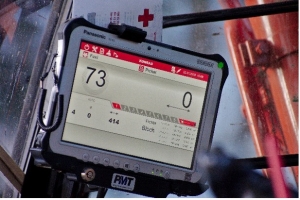
Production reports and control measurements now have been built into the latest Konrad onboard computers.
While some foundation has been laid from the technological perspective, multi-actor approaches are needed for the enhanced uptake of digital tools. Particularly, the focus needs to be directed at providing more training on how to use digital tools for all actors engaged in forest operations.
Actors need to see the benefits from a total supply chain perspective, especially when a solution is provided that they may not have considered before. SILVISMART is a good European innovation show case as it supports engagement and unveils some of the power of digital evolution, even perhaps being able to create a revolution in making forest management more sustainable.
SILVISMART to support entrepreneurs
T4E is supporting and contributing to this topic to allow entrepreneurs to use SILVISMART which should enable the processes for:
- Monitoring production volumes over time and ensuring the efficient use of resources in highly mechanised timber harvesting in steep terrain.
- Supporting entrepreneurs with key figures on harvesting operations in mountainous regions.
- Smoothing transport logistics by sharing information on produced volumes with all involved partners within an ongoing cable yarding operation.
- Keeping an eye on cost and production figures that will enable increased flexibility by being able to react to changing environmental and operating conditions in steep terrain harvesting operations.
Konrad Forsttechnik is a family-owned Austrian company specialising in wood harvesting machines for extreme steep slopes and difficult terrain. The company’s harvesters and technologies can be viewed HERE.
References:
Prem 2020: Holzeinschlagsmeldung über das Kalenderjahr 2019. Medieninhaber und Herausgeber: Bundesministerium für Landwirtschaft, Regionen und Tourismus Abteilung III/1, Marxergasse 2, 1030 Wien. Redaktion: DI Johannes Prem, Helga Bauer.
This project has received funding from the Bio Based Industries Joint Undertaking under the European Union’s Horizon 2020 research and innovation programme under grant agreement No 720757.
________________________________________________________________________________________________________________________________
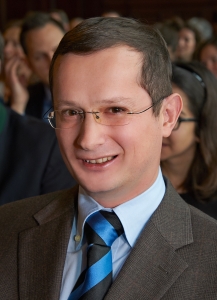
Dr Christian Kanzian is Assistant Professor at the University of Natural Resources and Life Sciences, Vienna (BOKU). His research focus includes forest operations and supply chain modelling, as well as statistical data analysis and mathematical optimisation. Teaching activities encompass Technical Drawing with CAD, Harvest Planning, Energy Wood Supply and System Engineering in Forest Operations in Bachelor and Master programmes at BOKU.
He has been working on a number of national and international projects dealing with the optimisation of energy supply up to life cycle assessment studies. Besides working on SILVISMART which has involved convincing foresters of the benefits that digital solutions could provide, he is co-ordinating value tracking in the EU ForestValue project GreenLane.
Christian has maintained the symposium website FORMEC for over a decade. The 50 year-old FORMEC forum is an event where forest engineers meet and discuss ideas.
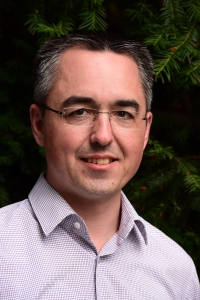 Dr. Franz Holzleitner teaches and conducts research as a senior scientist at the Institute of Forest Engineering located at the University of Natural Resources and Applied Life Sciences in Vienna (BOKU). His research interests and teaching activities include timber harvesting, timber transport and forest road construction.
Dr. Franz Holzleitner teaches and conducts research as a senior scientist at the Institute of Forest Engineering located at the University of Natural Resources and Applied Life Sciences in Vienna (BOKU). His research interests and teaching activities include timber harvesting, timber transport and forest road construction.
He has been involved in a number of national and international projects, with a particular focus on the analysis of time and fuel consumption of transport processes of round wood and wood chips based on long-term machine data, especially using a commercial fleet management system.
Within Tech4Effect he contributed to the deliverable “Novel indicator-based classification of forest road types and forest road maintenance status — approach and case study”. He also was involved in the field study on “Traction-assist forwarding on flat terrain”, which resulted in a scientific article published in the International Journal of Forest Engineering which can be viewed HERE.
His most recently completed national project, which ended in January 2021, dealt with debarking heads for bark beetle infestation control which can be viewed HERE.


